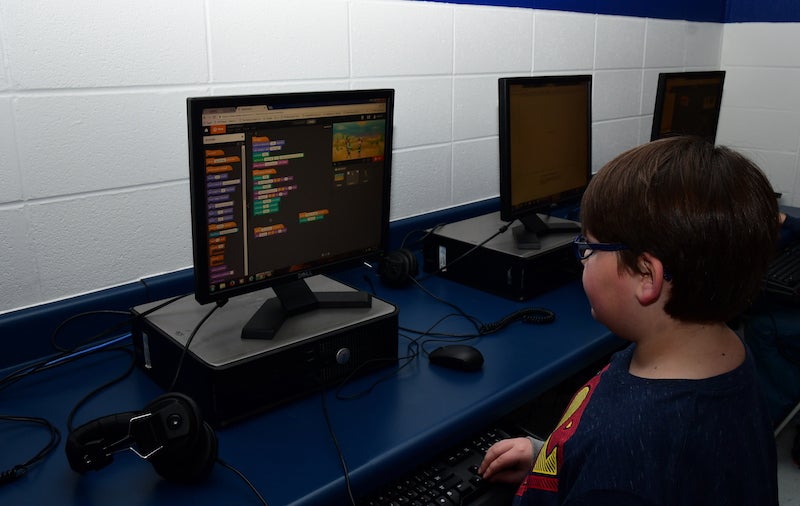Computer science courses to be required
Published 4:05 pm Thursday, July 18, 2019

- A Chilton County Schools student uses a program to learn basic programming. By 2023, computer science will be a required course at each stage of Alabama students K-12 education. (FILE)
|
Getting your Trinity Audio player ready...
|
By JOYANNA LOVE/Senior Staff Writer
More computer science classes will be offered in Chilton County schools in the coming years to meet state requirements that will begin to take effect in 2020.
In the 2019 legislative session, a bill became law that requires students to take computer science courses at each stage of their K-12 education.
“The law says that one class in high school will be required to be taught by the 2020-2021 school year, instruction offered in middle school by the 2021-2022 school year and instruction offered in elementary school by the 2022-2023 school year,” CCS Superintendent Jason Griffin said.
A new computer science course will be offered in the 2019-2020 school year at LeCroy Career Technical Center as a dual enrollment course through Jefferson State Community College.
Griffin said he was “excited” about offering this class.
“I personally believe that the computer science requirement is needed and will benefit our students now and in the future,” Griffin said. “Information technology is rapidly growing, and we must make sure our students are prepared.”
Several schools are already offering computer science courses that would meet the state requirements. These classes include a high school computer science course, AP Computer Science Principles and Computer Science Principles.
According to technology coordinator Kim Arrington, computer science was taught at LeCroy Career Technical Center as well as Jemison, Thorsby and Verbena high schools.
AP Computer Science was taken by Isabella High School students via ACCESS online learning.
Students from Isabella and Chilton County high schools also enrolled in web design and computer programming classes through ACCESS.
According to Arrington, 119 students were enrolled in the classes.
Although specific computer science classes were not offered at Clanton or Jemison middle schools, Griffin said he hopes the Project Lead the Way classes, which includes computer science, offered at these schools would meet the requirements.
Computer science has not been offered at Maplesville High School, and no students enrolled in computer science ACCESS classes in the 2018-2019 school year.
Some funding is set aside in the law to help with implementation.
“The law provides for funding for professional development for computer science instruction, provides multiple certification pathways to allow teachers to become certified to teach computer science,” Griffin said.
A plan for implementation of these additional required courses is in the works.
“Our plan for implementation is currently being developed, but we plan to teach it in elementary school within the existing classroom, so the classroom teacher would teach it in their own classroom or if they weren’t certified, then a teacher who is certified would teach it to multiple classes,” Griffin said. “In middle school and high school, we are planning on a separate course in some form for the students. However, it is all still in the planning stages. Thankfully, we have some time before it is fully implemented in 2022-2023.”
This summer several teachers attended a professional development training at Thompson High School for teachers of computer science. During the four days of training, teachers became familiar with and practiced teaching the Code.org Computer Science Discoveries course.
“It was a great way to dive deep into the lessons and get a taste of how we would teach it in our classrooms,” Jemison Intermediate teacher Katie Maddox said.
Maddox said the Computer Science Discoveries course is a beginner course designed for upper elementary and middle school students as a foundation before high school classes.
Maddox said she wanted to attend the training “to get a head start on teaching the new Digital Literacy Computer Science standards.”
“Computer science is an extremely fast growing field, and more and more schools are adding computer science classes into their curriculums,” Maddox said. “This training provided another option, in addition to the Project Lead the Way classes our schools already have.”
Marjorie Littleton said the training gave her more tools for teaching computer science through the Project Lead the Way program. While she has used Code.org curriculum in the past, Littleton said the program has been updated and changed, so the program helped her “learn some new techniques.”
“The new gateway program, which is what we were trained in includes a curriculum to teach students html to make their own website,” Littleton said.
The new curriculum uses a program called Blockly to help students write computer code.
“It’s a simplified form of programming and it also teaches basic JavaScript,” Littleton said.
She said the new Code.org program teaches more complex topics “to prepare students for AP Computer Science Principles.”
She said the courses help prepare students “to pursue a career in computer science.”
Littleton said she was also able to get information about having Jemison High School offering AP courses, making them eligible for additional resources through the AP program.
“There were many great teachers there, so collaborating with other professionals and sharing teaching strategies was very helpful,” Maddox said.
The new law also requires the creation of a state computer science specialist position at the State Department of Education, “secondary and postsecondary graduation credit and admissions pathways in computer science for students” and “multiple computer science certification pathways for public school teachers, including requirements for institutions of higher education to provide preservice coursework that leads to certification in computer science.”






